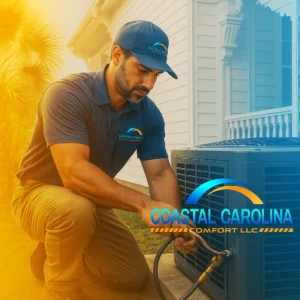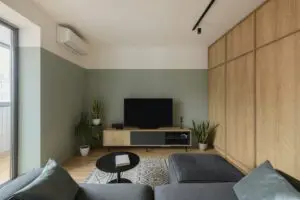When your HVAC system starts making a whistling sound, it can be more than just annoying. That high-pitched tone might be your system’s way of letting you know something isn’t quite right. Whistling doesn’t usually mean a major breakdown is coming, but it’s definitely a sign that there’s a problem worth paying attention to. In many Charleston homes, this noise shows up during the hottest months, when your system is working overtime to keep the house cool.
Understanding why your HVAC sounds like a tea kettle is the first step to fixing it. Even if everything still seems to be working, those sounds can be early signs of larger issues, like air restriction or poor airflow. If left unchecked, it could lead to higher energy bills or uneven cooling from room to room. Fortunately, there are some common causes that you can keep an eye out for before the whistling gets worse.
Common Causes Of Whistling Sounds In HVAC Systems
A whistling HVAC system isn’t just irritating—it’s usually a signal that air isn’t flowing the way it should. Here are some of the most common issues that tend to cause whistling in Charleston homes:
– Blocked air filters: When filters get too dirty, air struggles to pass through. This leads to pressure build-up and a whistling sound as the air forces its way through small gaps. Regularly replacing your air filter every couple of months helps avoid this.
– Undersized or restricted ductwork: If the ducts are too narrow for the type of airflow your system pushes, the air can become compressed and whistle as it rushes through. Ducts may also have bends or kinks that create tight spots.
– Partially closed or obstructed vents: If a room’s supply vent is covered by furniture or intentionally closed off, the extra pressure forces air to redirect, leading to noise. Even slight blockage, like dust buildup on vent grilles, can make a difference.
– Leaky return ducts: Air escaping through holes or poor connections in the return duct system can make whistling sounds as it pulls air from unintended places.
Imagine trying to breathe through a straw that’s pinched on one end. That’s basically what your HVAC system is doing when something restricts airflow. It struggles, and that struggle makes noise. Once the air has nowhere else to go, it finds other paths, and those paths can produce whistling as pressure builds up.
The good news is these are all fixable with the right approach and catching them early helps prevent bigger headaches later
Diagnosing The Problem
Tracking down the source of a whistling noise can feel like looking for a leak in a tire. You know something’s off, but it’s not always easy to spot. Still, there are a few simple things you can do before picking up the phone.
Start by walking through your home and checking all the vents. Make sure none are blocked by rugs, curtains, or furniture. Then, look at the vent blades on each register. They should be fully open to let air pass through smoothly. If they’re closed or only partly open, opening them up might reduce the noise right away.
Next, pop open the area where your system’s air filter lives. Pull it out and take a look. If the filter is covered in dirt or dust, that could easily be your problem. Replacing it with a clean one every one to two months is usually enough to avoid airflow issues and often clears up whistling problems fast.
Sometimes the problem is deeper inside the system. A duct that’s come loose or is too small for the system can create pressure and noise. Loose seals or holes in the ducts can also pull in outside air, setting off that high-pitched sound. At that point, you’ll want to get someone out who can inspect and adjust the system professionally.
Catching these early not only cuts down on noise but also helps your HVAC in Charleston run cooler, smoother, and more efficiently all summer long. The sooner you act, the less likely it is for a small issue to grow into a much bigger one.
Solutions to Prevent and Fix Whistling Sounds
To get your HVAC system running smoothly, sometimes it takes more than just regular checks. When you find yourself dealing with a persistent whistling, it might be time to address some practical fixes. Here are a few steps that can help keep everything operating the way it should.
1. Replace Air Filters: One of the easiest ways to reduce whistling sounds is by changing dirty air filters regularly. This helps keep airflow steady and your system efficient.
2. Check and Adjust Vents: Walk through each room in your home and make sure the vents aren’t blocked by furniture, curtains, or rugs. Open the vent blades fully so air passes through without resistance.
3. Inspect Ductwork: Ducts that are too small or have kinks and tight turns can create pressure buildup that causes that whistling sound. A professional can evaluate your ductwork and make sure it’s appropriately sized and connected.
4. Look for Duct Leaks: Air escaping through loose or broken ducts can produce high-pitched noises. Sealing those leaks or reattaching loose sections can help solve the issue.
If the whistling continues after these steps or returns later, it’s time to contact a professional. A skilled technician can safely inspect the ducts and the entire HVAC system to make lasting repairs. Handling these issues the right way prevents bigger problems down the line and keeps your home temperature just the way you want it.
Preventive Measures for a Quieter HVAC System
The best way to avoid HVAC noise is to stop problems before they start. With routine care and a few simple habits, your system can stay quiet and efficient. Here are a few steps to help keep whistling sounds from showing up again.
– Schedule Regular Inspections: Having a technician inspect your system each year helps catch problems early. With trained eyes on your setup, any airflow restrictions, leaks, or wear can be taken care of quickly.
– Keep Vents Unblocked: Double-check that vent areas aren’t covered or restricted. An open space around vents helps air move without buildup or pressure changes.
– Maintain Clean Filters: Changing filters every month or two really makes a difference. When filters are clean, airflow stays smooth and your system doesn’t have to work harder than it should.
– Upgrade When Necessary: Older systems can experience more noise due to worn parts or outdated designs. If repairs are becoming frequent, talk to a technician about whether an upgrade would make sense. New models are generally more efficient and much quieter.
Creating a habit of HVAC maintenance helps avoid whistling and keeps the entire system running consistently. Simple steps now can save you a lot of stress down the road.
Enjoy a More Comfortable and Quiet Home
Fixing the whistling from your HVAC system makes your house feel more relaxing right away. That annoying noise fades, and the air moves freely where you need it. Whether you’re trying to sleep, have a family dinner, or just enjoy your living space, a quiet system makes everything feel better.
Addressing air flow issues and handling minor problems early keeps things from getting more expensive later. And when professionals take care of more complicated repairs, you get peace of mind that things are done the right way.
For homeowners in Charleston, solving HVAC issues like whistling is part of keeping your space as comfortable as possible year-round. Let Coastal Carolina Comfort help you stay cool, calm, and confident your system is working the way it should.
For a peaceful and comfortable home environment, addressing those whistling sounds is key. If you want a hassle-free solution and expert guidance, trust Coastal Carolina Comfort to pinpoint and resolve any issues. Our team is ready to provide the support you need to keep your system whisper-quiet and running smoothly. Learn how our services for HVAC in Charleston can make a difference in your home’s comfort.


